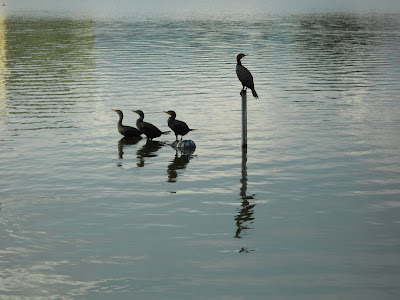There was a Male Mallard
And his Mate along with some Seagulls (I don't know what kind of gulls these are and I can not find them on line so if anyone has a birding book (Sara) and can identify them please let me know in comments.)
A Great Blue Heron
Mute Swan (There were lots of swans here, a whole lotta swans.)
A Wood Stork, that Swan in the background is the same one in the earlier picture, He was stalking us along with a couple of ducks whom all thought if they waited just a few paces behind us we might accidentally drop bread that they insisted we had. (Which we didn't)
A
*This is actually a Tolouse Goose.
*There might be a Cormorant or two here but at least 2 of these guys are Anhinga.
A flock of American White Pelicans with a wood stork (bottom right) and a
A closer look at the
*Bzzzt wrong again Suzi! This is actually a a female Anhinga. Cormorants don't have such a snake like head.
A American White Pelican settling down for the night. (Thats a male Mallard paddling by in the background)
I have to say it was a pretty fun afternoon. We plan on going back next weekend to see if we can find any of the black swans that I hear are there. Wish me luck!
*All corrections are courtesy of "The Amazing Sara" and her most awesome bird book.










What an awesome gift, and what great pictures! John's a keeper, I think. ;)
ReplyDeleteBird questions! Okay, well, your gull there...I'm terrible with gulls, mind, but I do know that that one is a juvenile. Beyond that...I'm not sure. I thought it might be a juvenile herring gull, but they have more black on their beaks, and don't have the markings around the eyes, like that guy does. It might be a ring-billed gull juvenile.
As for your goose guy...That is actually a Tolouse, which is a common breed of domesticated goose. They're easy to identify because they're so big, and most wild geese aren't that bottom-heavy.
Your second cormorant is actually a female anhinga; you can tell by the coloring on her neck and chest. :) They're really similar to cormorants, but actually belong to a different family called darters. They've actually got longer, more snakelike necks than cormorants do.
Hopefully that helps! :)
--Sara
Thank you for all your identifications Sara. I finally got around to correcting this post and crediting you for it, just in time for you to do it all again with todays post. ;P
Delete